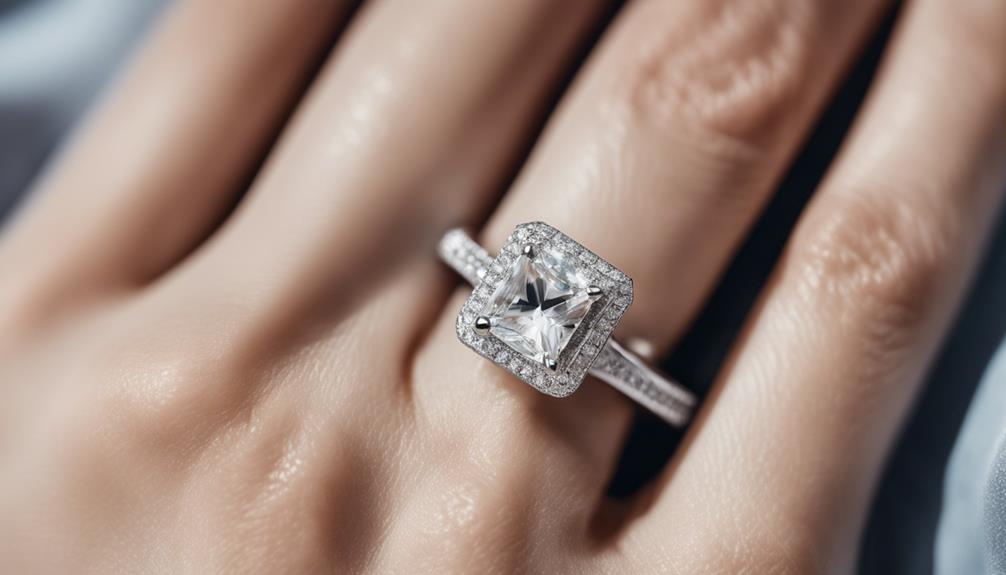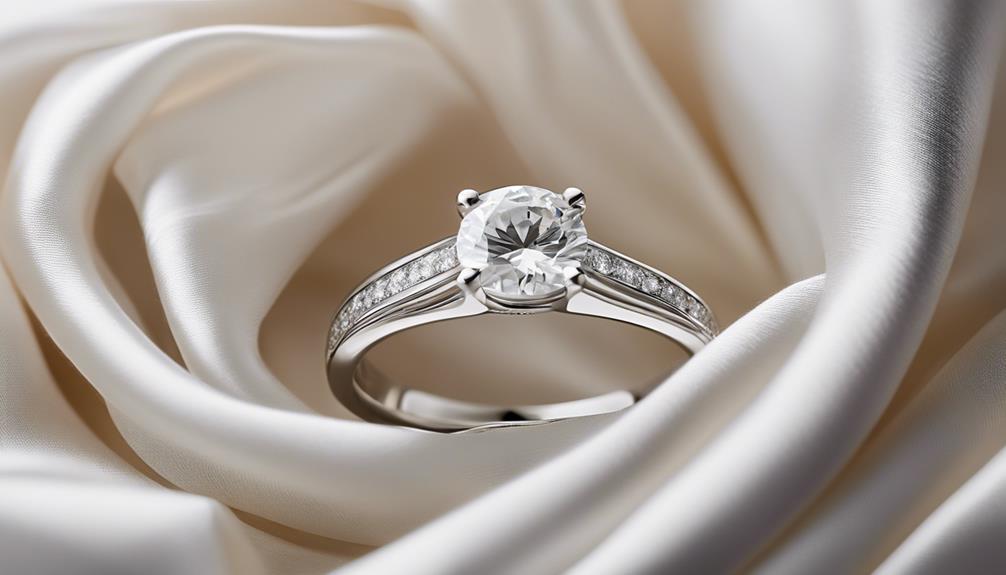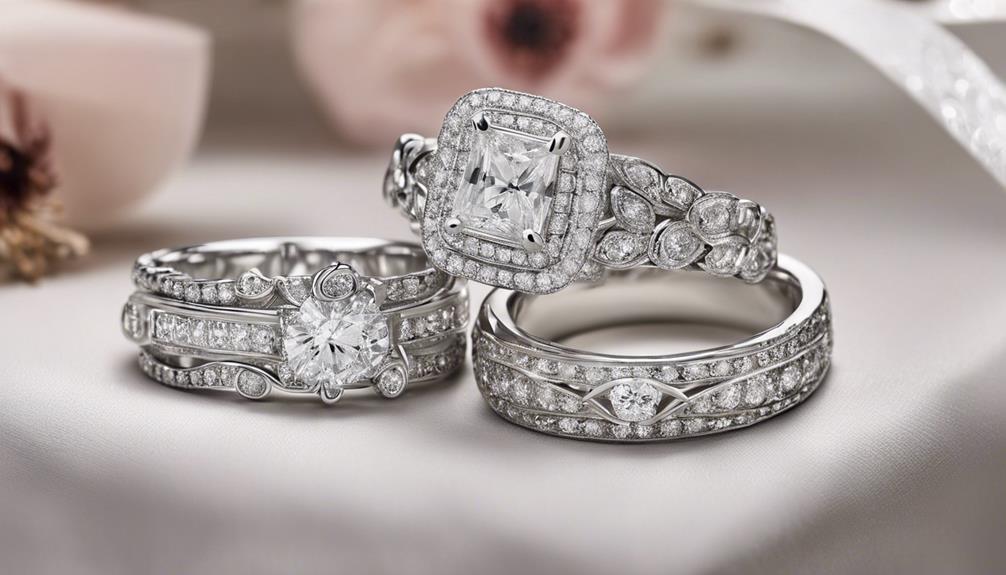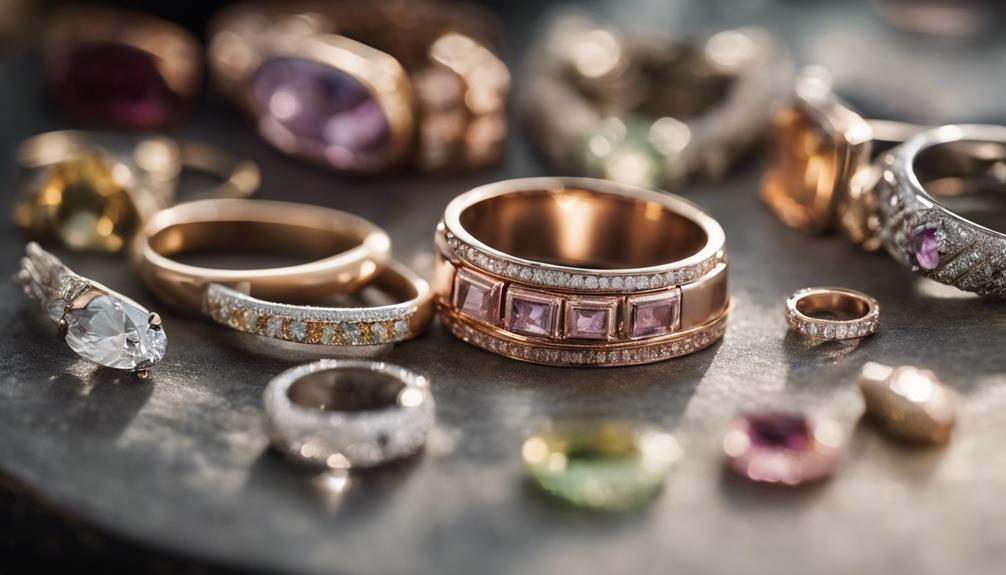When choosing the best material for an engagement ring, consider durability, cost, and style. Platinum is incredibly durable and hypoallergenic but comes at a higher cost. Yellow gold offers a classic look with minimal maintenance and various purity levels, while white gold provides a modern, affordable alternative with a sleek finish. Rose gold‘s romantic hue is unique but needs regular upkeep due to its copper content. Sterling silver is budget-friendly but less durable. Think about what matches both your lifestyle and aesthetic preferences. Exploring these options further will help you make an informed decision on this important purchase.
Platinum: Pros and Cons

Choosing platinum for your engagement ring offers both durability and elegance. This naturally white metal is celebrated for its remarkable longevity and purity, being 95% pure.
As one of the most durable options available, platinum stands up to the rigors of everyday wear, making it a practical choice for those who want their ring to withstand the test of time. You won’t have to worry about scratching or tarnishing, as platinum is known for its resistance to these common issues.
Additionally, if you have sensitive skin, platinum is a hypoallergenic metal, reducing the risk of irritation and ensuring comfort. This makes it an excellent choice for daily wear without any concerns about potential allergic reactions.
However, it’s important to note that platinum comes with a higher price tag. Its rarity and durability contribute to its cost, often making it more expensive than gold options.
While this might initially seem like a drawback, the long-term benefits of choosing platinum can outweigh the upfront expense. Its substantial feel due to its density adds to its allure, offering you a luxurious and enduring symbol of commitment.
Yellow Gold Characteristics
Yellow gold has long been celebrated for its warm, rich color and timeless appeal, making it a classic choice for engagement rings. As a naturally occurring precious metal, yellow gold is known for its luxurious look and versatility. When choosing yellow gold for your engagement ring, you’ll want to evaluate its durability and various karat options that best suit your lifestyle.
- Karat Options: Yellow gold engagement rings are available in 10k, 14k, and 18k. The higher the karat, the more pure gold it contains. An 18k ring offers a more luxurious feel with 75% gold content, while 10k and 14k provide greater durability with added alloy metals.
- Durability: While pure gold (24k) is too soft for everyday wear, yellow gold is typically alloyed with copper and zinc to enhance its strength. This makes it durable enough for daily use without compromising its beauty.
- Low Maintenance: Unlike white gold, yellow gold doesn’t require rhodium plating, so it maintains its consistent appearance over time without frequent upkeep.
- Versatility: Its warm hue complements various diamond shapes and colored gemstones, enhancing their brilliance and aesthetic appeal.
White Gold Benefits

White gold offers a sleek, modern appeal with its silvery-white finish, making it a favorite for engagement rings. It’s crafted from yellow gold mixed with precious metals like nickel or palladium, resulting in a stunning look similar to platinum. One of the standout benefits of white gold is its affordability compared to platinum, allowing you to achieve a luxurious appearance without breaking the bank.
In terms of durability, white gold holds its ground well. By combining gold with alloys such as copper, it becomes more durable than pure gold, making it suitable for everyday wear.
To boost its shine and scratch resistance, white gold is often coated with rhodium plating. While this enhances its luster, keep in mind that the plating can wear off over time, necessitating periodic re-dipping to maintain its brilliance.
However, if you or your partner are sensitive to nickel, it’s crucial to explore nickel-free white gold options. These are typically made with palladium, offering a hypoallergenic alternative.
Exploring Rose Gold
Celebrated for its romantic allure, rose gold has become a favored choice for engagement rings, thanks to its unique rosy hue and vintage charm.
It’s crafted from yellow gold mixed with copper, offering a distinctive romantic look that stands out from traditional yellow and white gold options. If you’re considering rose gold for your engagement ring, here are some key points to keep in mind:
- Color and Composition: Rose gold’s beautiful color comes from its composition. 18K rose gold, made of 75% gold, provides a richer hue, while 14K, with 58.5% gold, is more affordable and boasts enhanced durability.
- Skin Compatibility: The copper in rose gold can cause allergic reactions for those with sensitivities. It’s essential to guarantee skin compatibility to avoid discomfort.
- Durability: Rose gold’s durability is comparable to that of yellow gold, making it a solid choice for everyday wear. However, regular maintenance is needed to prevent tarnishing and keep its shine.
- Popularity: In recent years, rose gold engagement rings have become increasingly popular, celebrated for their romantic aesthetic and ability to capture timeless elegance with a touch of modern flair.
Selecting rose gold for your engagement ring offers a blend of tradition and contemporary romance.
Comparing Silver Options

When considering silver options for engagement rings, sterling silver stands out as a popular choice due to its affordability and classic appeal. Its composition of 92.5% pure silver mixed with other metals enhances its durability, offering a budget-friendly alternative to more expensive metals like gold or platinum.
However, if you’re thinking of sterling silver for an engagement ring, it’s important to weigh its pros and cons carefully.
Sterling silver is known for being less durable compared to gold or platinum. While it’s strong enough for occasional wear, it’s softer, making it more susceptible to scratches and dings, especially if worn daily. This could be a concern if you’re planning to wear your ring every day, particularly if your lifestyle is active.
Additionally, sterling silver is prone to tarnishing over time, meaning you’ll need to invest some effort into regular maintenance, like polishing and cleaning, to keep it looking its best.
Despite these considerations, the affordability of sterling silver makes it an attractive option for those on a budget.
However, for a ring that symbolizes a lifetime, you might want to explore other materials if durability and everyday wear are priorities.
Conclusion
When choosing the best material for your engagement ring, consider what truly resonates with you. If you prioritize durability and hypoallergenic properties, platinum is outstanding. For a classic, timeless appeal, yellow gold might be your perfect match. If you prefer a modern look with affordability, white gold stands out. Don’t forget rose gold’s unique charm or silver’s budget-friendly allure. Ultimately, your ring should symbolize your unique love story, so trust your instincts and make a choice that feels right.



